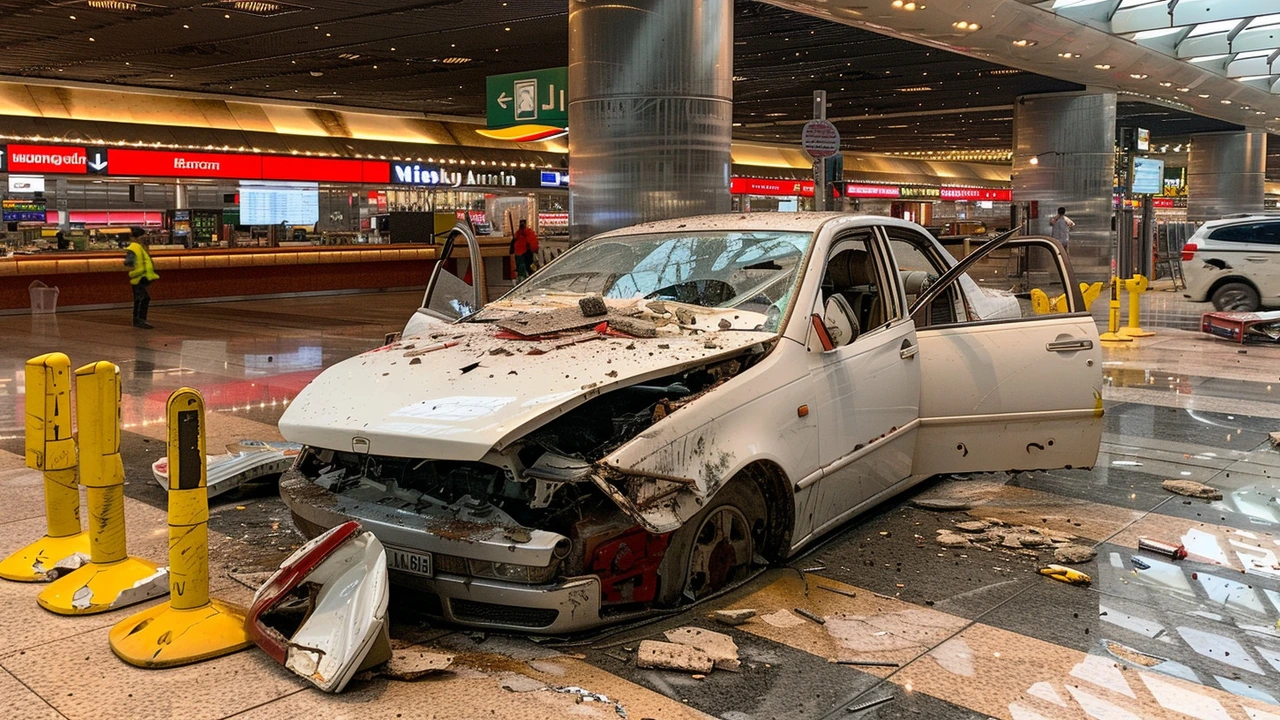Calamity Strikes Terminal 1 at Delhi's Indira Gandhi International Airport
The serenity of the usual morning bustle at Delhi's Indira Gandhi International Airport was shattered on Friday, 28 June, when the roof of Terminal 1 unexpectedly gave way. Passengers and staff were thrust into chaos as the collapse resulted not only in the tragic loss of one life but also inflicted injuries upon at least six others. The calamity led to the immediate grounding of all activities in the terminal, pushing a string of airline operations into disarray.
The grisly incident stemmed from an unrelenting downpour that had plagued the area. In a notably short span of three hours, the airport experienced a staggering 148.5 mm of rain, far surpassing the average forecasted for June 2024. This deluge proved the final straw for the ailing architecture of Terminal 1, whose roof crumbled under the weight of the accumulated water. To put the situation into perspective, the Safdarjung Weather Station recorded an unprecedented 228.1 mm of rainfall within 24 hours, establishing it as the heaviest in a single June day over 88 years.
Impact on Airline Operations
In the aftermath of the collapse, over 80 flights were cancelled, leaving thousands of travelers stranded and frustrated. Indigo bore the brunt of the cancellations, axing a significant portion of its scheduled departures. Meanwhile, SpiceJet also had to call off approximately 15 flights. In an endeavor to mitigate the disruptions, the flights were rerouted to Terminals 2 and 3, where the airlines attempted to re-stabilize their operations. However, the logistical nightmare of accommodating the displaced passengers proved to be a monumental task.
Government Measures to Curb Airfare Surge
Recognizing the substantial impact on travelers, the Ministry of Civil Aviation promptly intervened. The ministry dispatched a notice to all airlines, emphasizing the necessity to closely monitor airfares and implement measures to stave off any untoward hikes in ticket prices. There was a formidable concern that opportunistic price gouging could exploit the desperate predicament of stranded passengers, adding financial strain to their woes. Furthermore, the ministry advised airlines to generously waive penal charges associated with the cancellation and rescheduling of flights. This directive aimed to provide some relief to passengers already grappling with the sudden upheaval.
Unpacking the Consequences
The cascading effects of the T1 roof collapse have been far-reaching. The immediate concern of safely rerouting passengers and maintaining flight operations has been an arduous challenge for the airlines. Moreover, the financial implications are considerable, with both the airport authority and airlines incurring significant losses due to the abrupt halt in operations. The ripple effect has extended to passenger sentiment, with shaken confidence in the infrastructure's reliability.
Passengers' grievances have swelled, with many taking to social media to voice their discontent. Stories of missed connections, altered plans, and long waits have flooded platforms, painting a stark picture of the chaos on the ground. Some passengers have praised the swift response and support from airline staff, acknowledging the tireless efforts to manage the complex situation. However, others have criticized the seeming unpreparedness for such an emergency and questioned the robustness of airport infrastructure given the severity of monsoon rains.
Examining the Infrastructure Concerns
This incident has inevitably drawn scrutiny to the state of infrastructure at one of India's busiest airports. Questions are being raised about the robustness of architectural integrity and the preparedness for extreme weather conditions. Frequent travelers and industry experts alike are calling for a thorough review and audit of the structural health of airport facilities. The roof collapse at T1 is a stark reminder of the potential for disaster that lurks in aging infrastructure, especially under the stress of environmental changes.
In light of this event, the airport authority is expected to expedite ongoing renovation projects and implement rigorous safety checks. There is a pronounced demand for transparent reporting on the measures being taken to prevent such occurrences in the future. This includes better rainwater management systems, structural reinforcements, and protocols for swift disaster response.
Learning from the Incident
The T1 roof collapse serves as a poignant reminder of the unpredictability of nature and the impermanence of the man-made world. It underscores the importance of proactive maintenance and preparation. As the airport and airlines navigate the immediate fallout, the focus must also shift to long-term resilience strategies. Enhanced weather forecasting capabilities, better early warning systems, and a robust emergency response framework will be crucial in mitigating the impacts of similar events in the future.
For now, the priority is to ensure passenger safety, restore normalcy in operations, and provide the affected travelers with the support they need. This incident will undoubtedly be a case study in crisis management and infrastructure resilience for the aviation industry in India and beyond.







Comments
Henry Huynh
July 1, 2024 AT 08:04 AMroof just gave up lol
Don McBrien
July 2, 2024 AT 15:16 PMthis is heartbreaking. imagine being stuck there with no idea what’s going on. hope everyone’s safe and the airlines are really stepping up with refunds and rebookings. people deserve better than this.
Ed Thompson
July 3, 2024 AT 05:01 AMthis is a systemic fail. T1 was a time bomb waiting for monsoon season. infrastructure debt is real. we’re running airports like they’re 2005-era startups with duct tape and hope. someone needs to audit every concrete slab in the country before someone else dies.
Sara Reese
July 3, 2024 AT 19:31 PMyou know what this reminds me of? how we prioritize profit over people. always. 🙄
Richie Cristim
July 4, 2024 AT 17:05 PMso like 148mm in 3 hours is insane right like what even is that like normal rain is like 10mm a day
Shreyas Wagh
July 4, 2024 AT 21:07 PMDelhi’s monsoons don’t rain-they declare war. And the airport? Still wearing last decade’s armor.
Lindy Loo
July 6, 2024 AT 09:32 AMi just keep thinking about the people who were just trying to get home. maybe a flight to see their mom, or a job interview, or a birthday. and then-boom. the ceiling falls. it’s not just logistics. it’s trust. and right now, it’s shattered.
Lisa J
July 7, 2024 AT 07:08 AMso glad the government stepped in on fares. no one should get screwed financially because of a building failure. 💛
Bronwen Davies
July 7, 2024 AT 23:08 PMthis isn’t just about a roof. it’s about how we treat public infrastructure. we build it cheap, forget it, then act shocked when it collapses. we need a cultural shift-not just repairs.
Cindy Crawford
July 9, 2024 AT 10:41 AMthe 228mm in 24 hours? that’s record-breaking. but honestly if the roof was built to handle monsoon rains in 2008, it shouldn’t have lasted until 2024. basic engineering.
Markos Charatzas
July 10, 2024 AT 17:38 PManother indian failure. why do we keep trusting these crumbling systems? no one’s held accountable. just more press releases and empty promises
Lena Michaels
July 12, 2024 AT 12:12 PMso the government says no price gouging but somehow the airlines still made a killing on rebooking fees? yeah right. like i believe that
Lea Ranum
July 14, 2024 AT 07:46 AMthey should’ve just closed T1 years ago. i knew this was coming. i told my friend last year it was a death trap. now someone’s dead. and no one even apologized properly.
Linda Lewis
July 15, 2024 AT 18:04 PMstay safe everyone.
Pinkesh Patel
July 17, 2024 AT 17:41 PMthis is why we need better leadership. no one cares about public infrastructure until someone dies. then they make a tweet and move on
Jason Frizzell
July 18, 2024 AT 03:51 AMi’ve flown through T1 a dozen times. the AC was always broken, the lights flickered, and the signs were half missing. nobody said anything. now this. it’s not a surprise. it’s a tragedy waiting to be named.
Ethan Steinberg
July 18, 2024 AT 13:46 PMwhy are we even surprised? india’s infrastructure is a joke. america would’ve fixed this 10 years ago. we don’t let buildings kill people here.
Steve Williams
July 19, 2024 AT 05:18 AMthis is what happens when you don’t invest. simple. no magic. no politics. just money. they didn’t pay. now someone dead.
Andy Persaud
July 19, 2024 AT 14:58 PManother day, another airport collapse. can we just stop pretending this isn’t normal?
ANGEL ROBINSON
July 19, 2024 AT 23:30 PMthis isn’t just about rain or roofs. it’s about the failure of foresight. Every airport in a monsoon zone needs redundant drainage, load-tested structures, and emergency protocols written in blood-not bureaucracy. We’re not building for resilience. We’re building for budgets. And people are paying the price. This tragedy should trigger a national infrastructure audit. Not a press release. An audit. With teeth.